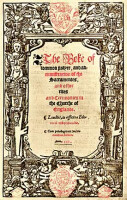Advent Liturgy from 1552
Sep 29, 2014 | by Ben Phillips

The Book of Common Prayer
1552
The Book of Common Prayer (BCP) has long been one of the defining characteristics of the Episcopal Church and the Church of England from which the Episcopal Church originates. Sometimes described as ‘the Bible arranged for worship’, the first BCP published in England in 1549 and was written by Thomas Cranmer, Archbishop of Canterbury (1489 – 1556). The liturgy in the BCP is built upon the great Western liturgies of the Catholic Church (some of the Collects date all the way back to the fifth century), but was strongly influenced by the Protestant Reformation in the 1500s. Cranmer revised the BCP in 1552, and this second prayer book is the one we are using.
All liturgy has a theological basis. What we say, sing, and pray, and the sequence in which they are done, has meaning and is intended to move the worshipper through a spiritual journey. That journey is directed by theology. Understanding this theological foundation is essential to understanding the liturgy. The 1552 BCP is built upon the idea that God alone initiates contact with lost and sinful people, and that God reveals himself through both the Law and the Gospel. “The Law” refers to God’s holy requirements for his people and establishes how we are to live and understand the appropriate boundaries God places on human behavior. While it is wholly good, the Law cannot actually make people good. In the end all the Law can do is show us what is right, and that we fall far short of its requirements. But God, who is rich in mercy, has promised to graciously forgive sinners and has reckoned them righteous because the Son of God, Jesus Christ, was reckoned with and condemned for their sins on the cross and his own perfect righteousness credited to the sinner. This wonderful promise, called “The Gospel”, is received through faith in Christ, and brought about solely by God’s good grace and not by our good behavior (or lack thereof!). This true and lively faith then produces good works in the believer: both the resistance to ongoing sin and loving service to others. The doctrine which describes how the Gospel ‘works’ in our lives is called justification by faith alone. This doctrine of justification by faith through God’s grace is the theological foundation of the 1552 liturgy.
The prayers and content of the liturgy in many ways has remained unchanged since 1552, and folks who are even a little familiar with the Rite 1 service of our current 1979 BCP will recognize much of the 1552 service. However, the order of the 1552 liturgy is quite different, and thus will seem quite unfamiliar. This is because the 1552 liturgy is based on a three-fold sequence of 1) Law, 2) Gospel, 3) Charity, or to put it another way, a three beat rhythm of sin-grace-faith. This pattern is then repeated three times throughout the service. Thus the first beat is that of confession or recognition of our shortcoming before God’s Law, the second beat reveals or focuses on the measure of God’s grace to sinners (Gospel), and the third beat has the congregation responding to God’s grace by, for example, making their offering or singing. Thus elements of the service which are quite familiar (like the Gloria, Offertory, and Prayer of Humble Access) are in ‘different’ places, because they are being used as components in a particular theological model. Rather than serving as preparation for hearing the Bible readings (as it is in our 1979 liturgy), the Gloria is at the very end of the 1552 service. The culminating response to God’s grace through hearing the law, repenting, trusting the Gospel promises through Word and Sacrament is to finally declare: “Glory be to God on high!”
In order to help those unfamiliar with this three-fold pattern and to better see the unfolding journey that the liturgy is taking us on, below is an outline of the service and its repeated three-fold cycle. Additionally, within the service itself each of the steps of this three-fold pattern, with helpful explanations, will be indicated in brackets for the corresponding part of the liturgy, e.g. [Law/Sin 2].
Please take some time to prepare your hearts and minds for this worship journey through God’s Law and Gospel, receiving God’s grace through his Word and Sacrament, and lifting your hearts and voices in praise to our Lord God.
First Cycle
- Sin – Collect for Purity, the Decalogue (Ten Commandments)
- Grace – Collect of the Day, Scripture readings
- Faith – Creed, Sermon, Offertory, Prayers (note, Creed comes before Sermon, not after, signifying the pattern of Word – doctrine – proclamation; that is to say, between the Bible and the preacher’s message must stand sound doctrine).
Second Cycle
- Sin – Exhortation, Confession
- Grace – Absolution, Comfortable Words of Christ and the Apostles (note how the liturgy specifically anchors these passages as the words of Christ and his apostles).
- Faith – Great Thanksgiving, Preface, Sanctus
Third Cycle
- Sin – Prayer of Humble Access
- Grace – Prayer of Institution, Words of Administration. Note, there is no epiclesis in the Prayer of Institution. Cranmer made the immediate reception of the Elements after the Institution the climax of Communion, not their prior consecration. Thus the sacramental miracle is not the changing of elements (transubstantiation) but the drawing of human hearts into the divine in the faithful reception of the Sacrament.
- Faith – Prayer of Oblation (Thanksgiving), Gloria. The Prayer of Oblation, in which we offer our selves and lives to God, comes as a result of God’s prior love to the sinful; only after we have received through faith (via Word and Sacrament) the gracious promises of God can we then rightly offer our lives to His service. The final act of worship then is to sing, “Glory be to God on high…!”
BTSP
